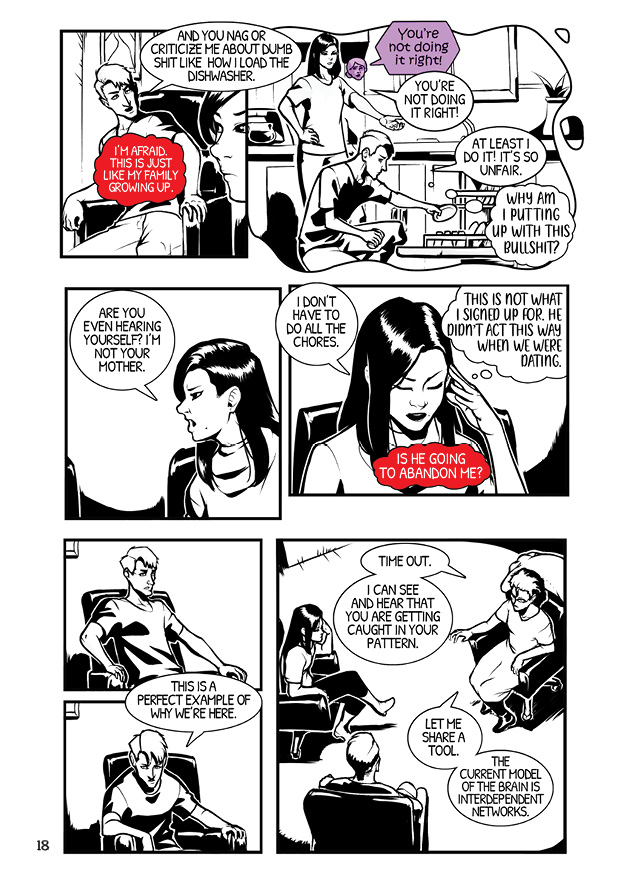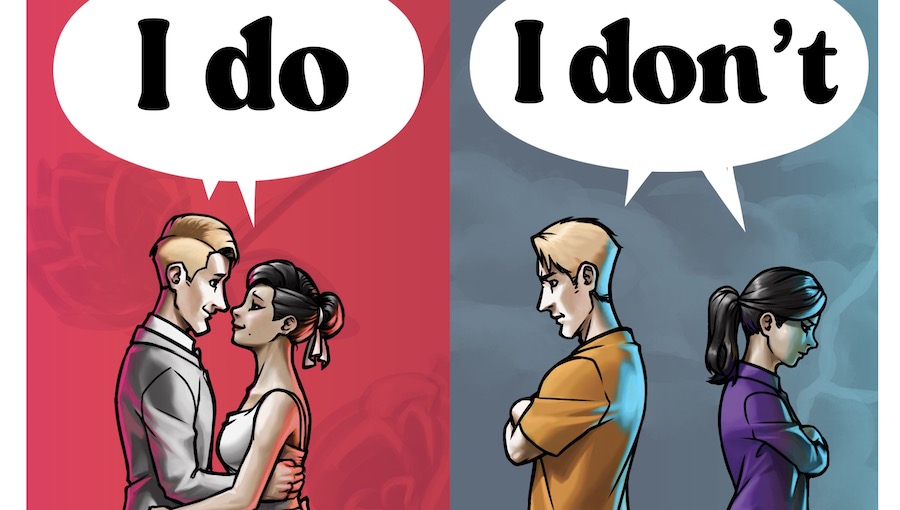The following is an interview with Licensed Marriage and Family Therapist Chandrama Anderson regarding the upcoming release of her graphic novel, I Do, I Don’t: How to Build a Better Marriage, through Soaring Penguin Press. In this interview, Fanbase Press Editor-in-Chief Barbra Dillon chats with Anderson about her shared creative process in bringing the graphic medicine story to life with artist Nur Jaffar Latip, what she hopes that couples may take away from the advice presented in the book, and more!
Barbra Dillon, Fanbase Press Editor-in-Chief: Congratulations on the upcoming release of I Do, I Don’t:! For those who may be unfamiliar, how would you describe the story’s premise?
Chandrama Anderson: Thank you so much, Barbra. I’m thrilled to be working on comics as a Licensed Marriage and Family Therapist. To steal a phrase from the BookLife review in PW on May 27, ’24: I Do I Don’t is “pure relationship gold.”
I Do I Don’t is the first in a series of an engaging story along with concrete tools to build better relationships. Readers go to couple’s therapy with Ben and Grace, learn what they learn, do the same homework, and use the free I Do I Don’t Companion Workbook. Readers will see Ben and Grace’s words, thoughts, and parental voices whispering in their ears, plus their unconscious feelings. It becomes clear how all of these interact and drive their emotions and behaviors—for better or worse. We get to see Grace and Ben at home, out with their friends, and in therapy, as they learn, struggle, and make progress implementing healthy new tools.
BD: What can you tell us about your shared creative process in working with artist Nur Jaffar Latip to bring this story and characters to life on the page, and how much of your own work in marriage and family therapy influenced the narrative?
CA: Collaborating with Nur is one of my greatest joys in this project. He’s a trained engineer and he’s been an artist since he was a boy. His grasp of body language and facial expressions is extraordinary. Imagine inking joy, anger, vulnerability, curiosity, humor, and more from differing POVs—and maintaining the accurate image of one character. It is not an easy task for an artist. I’d say Nur’s “The bomb.”
For most of his pages, I don’t have to give any feedback. And when I do, it’s subtle. Just changing a posture, shadowing, or raising an eyebrow conveys something completely different; and Nur draws exactly the feeling that I’m looking for. I’m a beginner in comics, and he’s so good at his craft. I gave Nur free rein to create more panels than I scripted to ensure that pages were not overloaded.
These days we have a weekly Zoom call and he draws while we talk. What a treat for the writer to watch! One specific example: Grace is upset, and in the script, it says to show her feeling defensive, anxious, and vulnerable, yet angry. Initially, Nur drew her as sitting forward, yelling. I knew it didn’t feel right, so I looked at the script. All I said to Nur was “Defensive not offensive.” Now he’s drawn Grace sitting back with her arms crossed and clearly upset and vulnerable. Two panels later she’s pulling herself together, which is believable to a reader.
All of my experience as a couple’s therapist went into I Do I Don’t. It’s based on the amalgamation of hundreds of couples I’ve seen since 2007, and no couple in particular. I wrote I Do I Don’t in 2020. In 2023 I showed an almost-finished version to a new couple in therapy, and they asked, “Did you write this about us?” While the answer to their question is “No,” that was a great compliment! The characters, their struggles, joys, and triumphs are universal. It became clear that many people have never had the opportunity to learn the basic building blocks of communication, connection, and kindness. I like to say, “You went to school, but no one taught healthy interpersonal skills.”
Here’s a revolutionary concept: Due to neuroplasticity, all of us can change our brain until the day we die. People talk about “muscle memory” which is actually referring to a neural pathway in the brain that’s strengthened by repetitive use. If we think differently and behave differently, we can actually change our own lives. You’ve heard the phrase, “Knowledge is power.” It’s the biggest gift you have: being kind to yourselves and each other, enacting the tools you’ll learn in each chapter. Think about it: You have the power in your own hands to rewire your brain and build better relationships with everyone. Please, only police yourself in using these new tools, and let your partner be in charge of him or herself.

BD: Graphic Medicine is an emerging genre that combines the field of medicine with the medium of comics. How do you feel that Graphic Medicine stories like this one can help to better depict not only relationship dynamics, but the tangible tools and practices necessary to heal mental well-being as both individuals and a couple?
CA: While I was in grad school to become a Marriage and Family Therapist, I created a means for clients to graphically represent their Attachment Style, early, and current life, challenges, hopes, and dreams for the future—in one session. In 2012 I turned that into a book for therapists and psychologists: Connect2 Personality Mapping. In retrospect, that was my first graphic book.
Without comics, I would have written the next 300-page book to help couples, joining the other 70,000+ couple’s titles on Amazon! Comics fulfill the saying that “A picture is worth 1000 words.” In actuality, there are only 60-100 words per page. Individuals see Ben and Grace’s thoughts, feelings, emotional reactions, and unconscious drivers—and then the words that spill from their lips. Readers recognize parts of themselves and realize, ‘I can try these tools, too.’ Throughout the story, Ben and Grace learn to speak thoughtfully and kindly—responsively, as opposed to the reactive way they used to communicate. They do the hard work, notice their own progress—and each other’s. Only images—comics—can convey all that.
Coming from a dysfunctional family myself, I realized that by offering tools for healthier adult relationships, maybe fewer children would be abandoned.
Every tool in I Do I Don’t is portable to all of your relationships: family, friends, kids, and coworkers. As you “Put it Into Practice’ as is at the end of each chapter and in the free Companion Workbook, individuals and couples are creating well-being and slowly healing their own and one another’s wounds.
Graphic Medicine—Comics—allows me to “Show and Tell” not, “Tell and tell and tell and tell.”
BD: What makes Soaring Penguin Press the perfect home for this story?
CA: Soaring Penguin Press is an Ignatz and Eisner-nominated publisher of comics and graphic novels. I saw a podcast of John Anderson [the publisher], in which he said he reads everything that’s sent to him. At the time, I had no idea that Graphic Medicine existed. Even so, I Do I Don’t ‘doesn’t’ fit into a category or box! Despite my book series being outside of SPP’s book categories, I took a chance and reached out to John. He took a chance on me, too. This is SPP’s first nonfiction title.
John saw the value—the public service, as he says—of publishing I Do I Don’t.
John’s been in comics forever, while I have ‘beginner’s mind’ when it comes to comics. When I decided to write I Do I Don’t, I had never read a graphic novel. No kidding! I’ve been a psychotherapist since 2007 and built my business and presentation skills in high-tech for 15 years before that. John and I are melding our backgrounds.
SPP hired Woodrow Phoenix as the book designer. Woodrow polished Nur’s layout, mostly the talk bubble locations, resulting in each panel shining. The book itself is gorgeous. I was stunned when I held it in my hands the first time: On the cover, the title and Ben and Grace are shiny and raised up from the two-color matte background. The pages are meant for the reader to write or draw on, and you can feel that in the paper. Therapy needs to be a warm and comforting environment, because it is hard work to look at our lives honestly and make the choice to practice healthier behaviors EVERY day. In my office with a couple, I can create a ‘safe-enough’ space with compassion, hope, and tangible tools to use now. John recognized that black-and-white printing would be too stark and cold, and that we could recreate that warm feeling by using cream-colored paper.
I’m learning about the world of comics every day, and so many people in addition to John have—and are—taking me and I Do I Don’t under their wings, helping bring it into the world for everyone. It’s astonishing, actually, and I am so grateful for their support and guidance.
BD: At Fanbase Press, our #StoriesMatter initiative endeavors to highlight the impact that stories can have on audiences of various mediums. How do you feel that this story may connect with and impact readers?
CA: Everyone from teachers to techies, carpenters to CEOs, students to shopkeepers, moms, dads, and my own family immediately get this story and the tools to change their own life and relationships. A woman literally bought the book out of my hand at a clothing shop! She said, “Even my husband will read this!” That’s the power of comics.
One of my biggest jobs as a therapist is to hold hope for my clients until they can hold hope for themselves. This creates the space to learn and implement new ways of thinking, speaking, and behaving—about themselves as well as each other. I Do I Don’t is my way of dropping a pebble in a pond for so many more people than I can reach couple-by-couple in therapy. As people’s self-talk changes, they are able to speak out in their families, communities, workplaces, and lifelong endeavors in healthier ways.
BD: Are there any upcoming projects on which you are currently working that you would like to share with our readers?
CA: I’m so glad you asked, Barbra! Nur is currently illustrating the second of four books in this series, which is called I Will I Won’t: How to Build a Better Relationship.
I’ve started Nur on another graphic medicine book that’s called Migraine, a full body experience: A guide for loved ones and coworkers. In a year, over 1 billion people worldwide have a migraine. I’ll be interviewing 20 to 25 people, and asking them to describe what their migraine actually feels like, as well as the top 3 to 5 things they need their loved ones to know, and the top 3 to 5 things they need from their coworkers/boss/school. Most migraine books are written to help people who have migraines; to overcome them as best they can. But there’s nothing for the people who surround them. Many people are passed over for promotions or their career suffers in some way due to their migraines.
Additionally, I’ve been approached by another publisher to write an Attachment Theory workbook.
BD: Lastly, what is the best way for our readers to find more information about I Do, I Don’t: How to Build a Better Marriage and your other work?
CA: Please visit my website: www.connect2relate.com. The first chapter of I Do I Don’t, the free Companion Workbook, plus information about my previous books and articles, couple’s blog, and resources are there for everyone. Please ask your local bookstore to order and stock I Do I Don’t, so others will find this treasure trove to build better relationships.

